Serviços Personalizados
Journal
Artigo
Indicadores
-
 Citado por SciELO
Citado por SciELO
Links relacionados
-
 Similares em
SciELO
Similares em
SciELO
Compartilhar
Acta Odontológica Latinoamericana
versão On-line ISSN 1852-4834
Acta odontol. latinoam. vol.26 no.2 Buenos Aires out. 2013
ARTÍCULOS ORIGINALES
Theoretical evaluation of nickel-titanium mtwo® series rotary files
Javier L. Niño-Barrera1,2, Mara C. Aguilera-Cañón 3, Carlos J. Cortes-Rodríguez 3
1 Department of Basic Sciences, School of Dentistry, National University of Colombia. Bogotá, Colombia.
2 Biomedical Engineering School of Medicine, National University of Colombia. Bogotá, Colombia.
3 Department of Mechanics and Mechatronics, School of Engineering, National University of Colombia. Bogotá, Colombia.
CORRESPONDENCE Dr.Javier L. Nino-Barrera Universidad Nacional de Colombia, Bogota, Colombia Calle 134 A #53 - 82 interior 9, apartamento 204. e-mail : jlninob@unal.edu.co
ABSTRACT
Nickel-Titanium rotary files are a technological development that enables dentists to prepare irregularly shaped root canals without altering them. Unfortunately, these files may fracture without any prior visible warning signs. The aim of this study was to perform a theoretical evaluation of the mechanical behaviour of MtwoR Nickel- Titanium rotary files for endodontics, in order to determine which of the files in the basic series are most likely to fracture. Mathematical models of the MtwoR basic file series were analyzed using the finite elements method. Bending and torsion loads were applied to the files both under normal conditions and under extreme conditions, to determine which of them had the highest Von Mises stresses. When the approximation was similar to normal use, none of the file models reached the maximum limit of failure by fracture. When used inadequately, file models 10/0.04 and 25/0.06 had the highest Von Mises stresses for bending and torsion, respectively. Thus, it is recommended that MtwoR files10/0.04 and 25/0.06 should be used once only, to prevent fractures.
Key words: Endodontic instruments; Nickel titanium alloy.
Evaluación teórica de las limas rotatorias de níquel titanio de la serie mtwo®
RESUMEN
Las limas rotatorias de Niquel-Titanio son un avance tecnologico que permite al odontologo llevar a cabo tratamientos en conductos con morfologias irregulares, sin alterarlas. Lamentablemente estos instrumentos pueden fracturarse sin presentar senales visibles que permitan prevenir este accidente. Por lo tanto el objetivo del presente estudio fue evaluar teoricamente el comportamiento mecanico de las limas rotatorias de Niquel-Titanio para uso en endodoncia MtwoR para determinar cual de los instrumentos de la serie basica es el que presenta mayor probabilidad de fractura. Con este fin se realizo un analisis por medio del metodo de los elementos finitos utilizando modelos matematicos de los instrumentos de la serie basica de las limas MtwoR. A estos instrumentos se les aplicaron cargas de flexion y torsion en condiciones normales y en condiciones extremas, para determinar cuales presentaban los esfuerzos de Von Mises mas altos. En una aproximacion similar al uso normal, ninguno de los modelos de las limas alcanzo el limite maximo de falla por fractura. Ante un uso inadecuado, los modelos de las limas 10/0.04 y 25/0.06 mostraron los esfuerzos de Von Mises mas altos tanto a flexion como a torsion respectivamente, por lo tanto se recomienda dar un solo uso a la lima 10/0.04 y a la lima 25/0.06 de MtwoR para prevenir la fractura de estos instrumentos.
Palabras clave: Instrumentos endodonticos; Aleacion niquel titanio.
INTRODUCTION
Biomechanical root canal preparation is the stage of endodontic treatment during which microbial pathogens - present as a result of dental pulp necrosis and decomposition - are removed, and probably the most important stage in non-surgical endodontic treatment1,2.
Disinfection is achieved by mechanical cleaning plus the use of irrigants and medicaments. It Root canal enlargement and preparation are essential to facilitate the flow of disinfectants and help with its definitive filling1,2 .
Small-calibre instruments, endodontic files in paricular, are used for biomechanical preparation. They were originally made of carbon steel, later on of stainless steel, and currently there are also files made of Nickel-Titanium alloys3-6.
One of the most important requirements for an ideal endodontic file is that it should not deteriorate or fracture7. The incidence of Nickel-Titanium rotary file fractures is reported as 5% to 21%, depending on its design7.
The fracture of an endodontic file inside the root canal is a procedural accident which significantly reduces endodontic success8, because the fractured fragment blocks the apical third of the canal and prevents eradication of the infection. The highest endodontic treatment failure rates occur when the initial diagnosis is necrotic pulp7-10.
Moreover, a fractured file inside a root canal is of concern to the patient, who of course will not wish to retain a piece of metal which has been impossible to extract from his tooth, and may even sue the dentist7.
Among of the most popular file designs in Latin America is MtwoR, which has an italic S-shaped cross-section and widely-spaced flutes.
The memory and superelasticity properties of Nickel- Titanium mean that these files show no visible deformation during endodontic treatment. This is at the same time their greatest and most dangerous disadvantage, because the operator does not notice any deterioration until the file fractures. It has been attempted to overcome this problem by recommending that Nickel-Titanium files be used once only, but in Latin American countries their high cost necessitate a rational application to this measure, since not all files in one series are equally likely to fracture. Thus, a recommendation is needed regarding which files may be used more than once, and which should definitely be discarded after one use due to the high probability of undergoing fracture if used again.
There are two ways in which an endodontic file can fail inside a root canal: torsional failure and bending failure. Torsional failure happens when part of the instrument becomes trapped in a section of the canal and the driving motor continues to turn, causing the file to fracture. Bending failure happens when the instrument acts on canals with moderate to severe curvature. Repeated compression and tension on the instrument at each revolution may cause fracture. A study of the tendency of Nickel-Titanium files to suffer torsional or bending fracture showed that torsional facture occurs in 55.7% of fractured files, while bending fatigue occurs in 44.3%11. Torsional and bending fracture can be evaluated by experimental methods, as well as by theoretical systems such as the finite elements method. The basic MtwoR set is made up of 4 files with different tapers, 10 / 0.04, 15 / 0.05, 20 / 0,06 and 25 /0,06, and although they work on the entire length of the canal, they are used from smallest to largest diameter in order to shape the root canal gradually. It would be useful to general dentists or endodontics specialists to know which file in the series should be given special attention in order to prevent fracture. Thus, the aim of this study was to use finite elements analysis to determine which file in the MtwoR series may theoretically have greater probability of fracture.
MATERIALS AND METHODS
Model construction
A reverse engineering process was performed at the metrology laboratory at the School of Engineering of Colombia National University. Measurements of Nickel-Titanium rotary files were taken with a Carl Zeiss Jenna profile projector, with a resolution of 0.01 mm, for geometric characterization and contour plotting of the files. Measurements of the MtwoR files were taken on the instrument profile at the widest and narrowest points along the entire longitudinal axis of the active part only.
Tensile stress test to determine the behaviour of the Nickel-Titanium alloy
The ASTM F2516 - 07 Standard12 test method for evaluating of Nickel-Titanium superelastic materials, which provides a typical stress-strain curve for their behaviour (Fig. 1), was used as a reference for an experimental study using a Universal Testing Machine for tensile stress loads (Shimadzu model AG-IS), which yielded a graph of the real behaviour of the Nickel-Titanium alloy.
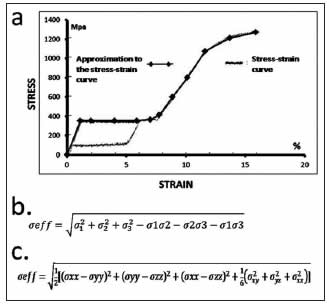
Fig. 1: a. Stress-strain curve and multi-linear approximation to the behavior of a nickel-titanium alloy. b. Equation used by the AutodeskR Simulation Multiphysics software to calculate Von Mises stresses. c. Equation used by AutodeskR Simulation Multiphysics software to calculate Von Mises stresse on Cartesian coordinates.
The test consisted of measuring tensile stress on a Nickel-Titanium (NiTiNOL) specimen 0.4 mm in diameter and 150 mm long. The specimen was subjected to traction up to 6% strain at a speed of a 0.04 mm/min.
Subsequently, the wire was unloaded at 7 MPa and then subjected to traction until it fractured at a speed of 0.4 mm/min. The experiment yielded a curve which was very similar to the one reported in standard ASTM F2516-0712 so it was decided to apply data from the stress-strain curve obtained to a simulation by means of finite element analysis. The following data were found for mechanical properties: Young's modulus 31650 MPa, maximum limit of failure by fracture 1270.588 MPa, yielding point 352.941 MPa, Poisson ratio 0.3 and density of the material 6.450 g/cm3.
The software Autodesk Inventor Professional R was used to construct each instrument based on the plots by estimating the working axis and generating the cutting helix around it, after which the characteristic MtwoR "italic S" cross section was applied. The Von Mises with Kinematic Hardening material curve was selected, because it allows an elastic-plastic material to be programmed, thus approaching the real behaviour of a Nickel-Titanium alloy. Previous studies have reported the use of this material model for analyzing finite elements with other software such as AnsysR and AbaqusR13-16. The model also allows a behaviour curve to be programmed according to known data, which may be either experimental or previously reported in the literature. Our study was able to program the material behaviour curve according to the experimental tensile test performed on the Nickel-Titanium specimen.
Numerical analysis of the failure criterion used in the finite element analysis
In order to perform failure analysis taking into account the Von Mises criterion, the AutodeskR Simulation Multiphysics software uses equation b (Fig. 1), where σ eff is the Von Mises equivalent stress and σ1, σ2 and σ3 are the principal stresses. The software can also perform the calculation using equation c, (Fig. 1), where σxx, σyy and σzz are the principal stresses applied in each element into which the model has been discretized, expressed in terms of Cartesian coordinates.
Meshing and application of stresses and restrictions on the 3-D CAD MtwoR Nickel-Titanium rotary files
AutodeskR Simulation Multiphysics software was used for finite element analysis for a study on threedimensional models based on the Brick element with 8 nodes and three degrees of freedom. In some cases it was combined with the tetrahedral element with 4 or 5 nodes, and also considered a number of elements which would enable an acceptable computing time (Table 1).
Table 1: Number of elements and nodes per file.
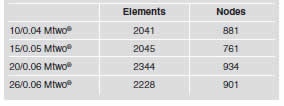
To simulate the file being trapped inside the canal and the consequent torsion the file is subject to, restrictions were applied to all degrees of freedom at the end of the file which is in contact with all the walls of the canal (Fig. 2a). We used the torque recommended by the manufacturer: 1.2 N.cm for file 10/0.04, 1.3 N.cm for file 15/0.05, 2.1 N.cm for file 20/0.06 and 2.3 N.cm for file 25/ 0.06. In addition, high torque was used to evaluate the behavior of the file under extreme conditions.
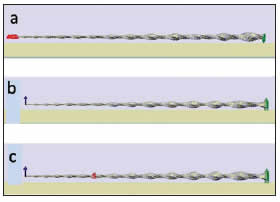
Fig. 2: a. Restriction at the tip and torque applied at file handpiece. b. Restriction in cantilever at the handpiece and force applied to the tip of the file. c. Restriction in cantilever at the handpiece and at 4 mm from the tip of the file, force applied at the tip.
To simulate bending, a restriction in cantilever was applied to all file models, as reported by Kim et al.14-16 A 1N load was applied to the tip of the file models (Fig.2 b) and a restriction was placed at 4 mm from the tip, to simulate the flexion a file undergoes when working in an apical curve (Fig.2 c). Finally, a 5N load - much higher than the previous ones - was applied, to determine the bending behavior of the file in this situation.
RESULTS
Results for Bending
Under normal working conditions, no file reached the failure limit. File 10/0.04 had the highest Von Mises stress. However, under extreme conditions, files 10/0.04 and 15 /0.05 might fail and fracture, with file 10/0.04 being the most likely to fracture (Fig. 3, Table 2).
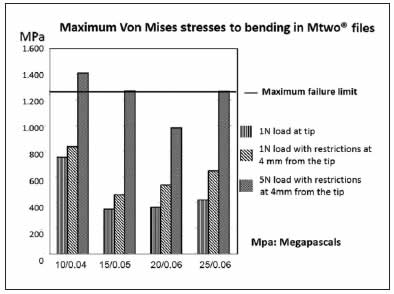
Fig. 3: Bending results for Mtwo® files.
Table 2: Bending results for Mtwo® files.

Results for Torsion
Here again, under normal working conditions, no file reached the failure limit, with file 20/0.06 having the highest Von Mises stress. However, upon applying high torque to simulate extreme working conditions, only file 25/0.06 reached the failure by fracture limit (Fig. 4, Table 3).
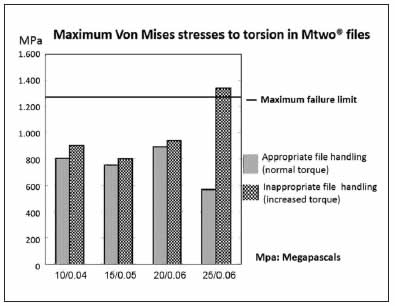
Fig. 4:Torsion results for Mtwo® files.
Table 3: Torsional results for Mtwo® files.

Figure 5 shows the result of the finite element analysis for the files which had the highest Von Mises stresses and the situations in which they occurred.
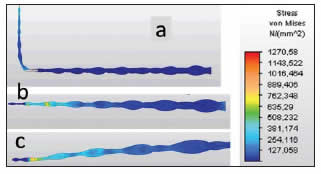
Fig. 5: Files with the highest Von Mises values: a. File 10/0.04 with restriction in cantilever and restriction at 4mm from the tip with 5N force applied to the tip. b. File 20/0.06 with restriction at the tip and 4N torque applied at the file handpiece. c. File 25/0.06 with restriction at the tip and 4N torque applied at the handpiece.
DISCUSSION
Because this is a simulation, not all clinical conditions can be replicated exactly. Nevertheless, appropriate approximations allowed the Nickel-Titanium rotary files to be evaluated mechanically. Turpin et al.17 evaluated torsion and bending by taking a segment of file and placing restrictions on one of its surfaces while applying torque on the opposite surface. They used 0.25 Nmm torque of to evaluate torsion, reporting that this value was selected because it is used by rotary instrument engine. In fact, the torque in enginesis much higher than 0.25 Nmm because they are programmed in Ncm. It should be noted that this fault in the approach appears in several of the finite element analyses reported in the literature14-18. In order to simulate bending behavior, a 1N load at the tip of the file has been reported14-16.
Applying the same load to all files allows evaluation under equal conditions of the Von Mises equivalent stresses which could lead to file failure. Regarding torsion, the approximations reported in the literature place restrictions in cantilever on the file and apply torque to the tip of the file14-16. In reality, files do not undergo this type of stress, but rather, the restrictions should be located at the most apical part of the canal, where the file touches the walls of the canal, and torque should be on the handpiece, i.e. the point at which the file is connected to the engine. Our results show that MtwoR file 10/0.04 had the highest Von Mises equivalent stress, thus, it may have the greatest tendency to failure by fracture due to bending stress. However, the results also seem to indicate that it is the most flexible file. Thus, the operator should be especially careful when using it. Nevertheless, being the most flexible file enables it to be used for endodontic treatment of irregularly shaped canals. It should be noted that if this file is used in a canal with moderate to severe curvature, it should not be reused for another treatment, since its mechanical properties may have been irreversibly altered, which may lead to a high possibility of fracture by bending if it is used again. MtwoR file 25/0.06 had the lowest Von Mises stress, suggesting that it may be the most resistant to facture by bending, but at the same time, the least flexible file in the series, therefore using it for endodontic treatment of canals with abrupt curves in an inappropriate manner (e.g. not following the proper order in the series of instruments) might lead to procedural accidents such as ledges, apical transportations or perforations of the root canal. For excessive load on the file (5N) with restriction at 4mm from the tip, it was interesting to observe that all files surpassed the bending limit for failure by fracture except file 20/0.06, suggesting that it would be less likely to fail than the others when dealing with a very abrupt curve. In this study, file 20/0.06 of the MtwoR series showed the highest value for Von Mises stress to manufacturer-recommended torque without reaching the failure by fracture limit. With higher torque, file 25/0.06 showed the highest Von Mises stress and reached the failure by fracture limit. However, an interesting finding was that even when used inadequately, the other files of the MtwoR series did not reach the failure by fault limit, suggesting that they may have temporary resistance to failure by fracture in the event of a procedural error.
Lee et al.19, found a correlation between the number of cycles that a file is used until it fractures (cyclic fatigue) and the maximum Von Mises stress in the instrument before failure. They suggest that as the number of cycles increases prior to fracture, the value of maximum Von Mises stress value decreases, i.e. in this case, the file would be more resistant to fracture, whereas if the file withstands few cycles prior to fracturing, the value of the maximum Von Mises stress increases and the file would be less resistant. On this basis, we will compare the results of clinical studies evaluating cyclical fatigue in MtwoR files to the results of our study. Plotino et al.20 found that when there was severe curvature, the MtwoR file 25/0.06 had the fewest rotations prior to fracture was (72 rotations). When the file worked under normal conditions, file 10/0.04 had the highest number of rotations prior to fracture (885 rotations). These are similar to the results of our study, which found that under difficult working conditions, file 25 /0.06 had highest Von Mises stress to torsion, and under normal working conditions, file 10 /0.04 had the lowest Von Mises stress to rotation.
Inan et al.21 found that MtwoR file 10/0.04 was the most likely to fracture by bending, in agreement with our study. File 25/0.06 came second, also in agreement with our analysis. Another study by Inan et al.22 on the MtwoR series found that file 20/0.05 was the least resistant to torsional fracture, again in agreement with our study.
To conclude, when MtwoR series files are used in an endodontic treatment, special care should be taken in the use of files 10/0.04 and 25 /0.06. They should be used once only, otherwise there is a high risk of fracture. However, in a root canal with moderate to severe curvature, file 10/0.04 is recommended because it is highly flexible and may respect the original root canal shape, avoiding accidents such as ledges or perforations. Similarly, caution is advised when using file 25/0.06 for which permeabilization or patency procedures are recommended to allow it to work freely in the root canal without the tip becoming trapped.
ACKNOWLEDGMENTS
We are grateful to the School of Engineering at Colombia National University for permission to use the laboratories for this study.
1. Schilder H. Cleaning and shaping the root canal. Dent Clin North Am 1974;18:269-296. [ Links ]
2. Gettleman BH, Aguirre R. Endodontic cleaning and shaping: current concepts. Endod Rep 1993;8:19-24. [ Links ]
3. Walia HM, Brantley WA, Gerstein H. An initial investigation of the bending and torsional properties of Nitinol root canal files. J Endod 1988;14:346-351. [ Links ]
4. Svec TA, Powers JM. Effects of simulated clinical conditions on nickel-titanium rotary files. J Endod 1999;25:759-760. [ Links ]
5. Peters OA. Current challenges and concepts in the preparation of root canal systems: a review. J Endod. 2004;30:559-567. [ Links ]
6. Baumann MA. Nickel-titanium: options and challenges. Dent Clin North Am 2004;48:55-67. [ Links ]
7. Cheung G. Instrument fracture: mechanisms, removal of fragments, and clinical outcomes. Enodontic Topics. 2009;16:1-26. [ Links ]
8. Sjogren U, Hagglund B, Sundqvist G ,Wing K. Factors affecting the long-term results of endodontic treatment. J Endod 1990; 16: 498-504. [ Links ]
9. Grossman LI. Guidelines for the prevention of fracture of root canal instruments. Oral Surg, Oral Med, Oral Pathol, Oral Radiol 1969;28:746-752. [ Links ]
10. Parashos P, Messer HH. Rotary NiTi instrument fracture and its consequences. J Endod 2006;32:1031-1043. [ Links ]
11. Sattapan B, Nervo GJ, Palamara JE, Messer HH. Defects in rotary nickel-titanium files after clinical use. J Endod 2000;26:161-165. [ Links ]
12. ASTM. Standard Test Method for Tension Testing of Nickel- Titanium Superelastic Materials. Current edition approved Dec 1, 2007 Published January 2008 Originally approved in 2005 Last previous edition approved in 2006 as F2516 - 06 DOI: 101520/F2516-07E02. Copyright by ASTM: ASTM; 2008. [ Links ]
13. Xu X, Eng M, Zheng Y, Eng D. Comparative study of torsional and bending properties for six models of nickel-titanium root canal instruments with different cross-sections. J Endod 2006;32:372-375. [ Links ]
14. Kim TO, Cheung GS, Lee JM, Kim BM, Hur B, Kim HC. Stress distribution of three NiTi rotary files under bending and torsional conditions using a mathematic analysis. Int Endod J 2009;42:14-21. [ Links ]
15. Kim HC, Kim HJ, Lee CJ, Kim BM, Park JK, Versluis A. Mechanical response of nickel-titanium instruments with different cross-sectional designs during shaping of simulated curved canals. Int Endod J 2009;42:593-602. [ Links ]
16. Kim HC, Cheung GS, Lee CJ, Kim BM, Park JK, Kang SI. Comparison of forces generated during root canal shaping and residual stresses of three nickel-titanium rotary files by using a threedimensional finite-element analysis. J Endod 2008;34:743-747. [ Links ]
17. Turpin YL, Chagneau F, Bartier, Cathelineau G, Vulcain JM. Impact of torsional and bending inertia on root canal instruments. J Endod 2001;27:333-336. [ Links ]
18. Zhang EW, Cheung GS, Zheng YF. Influence of cross-sectional design and dimension on mechanical behavior of nickel-titanium instruments under torsion and bending: a numerical analysis. J Endod 2010;36:1394-1398. [ Links ]
19. Lee MH, Versluis A, Kim BM, Lee CJ, Hur B, Kim HC. Correlation between experimental cyclic fatigue resistance and numerical stress analysis for nickel-titanium rotary files. J Endod 2011;37:1152-1157. [ Links ]
20. Plotino G, Grande NM, Sorci E, Malagnino VA, Somma F. A comparison of cyclic fatigue between used and new Mtwo Ni-Ti rotary instruments. Int Endod J 2006;39: 716-723. [ Links ]
21. Inan U, Aydin C, Demirkaya K. Cyclic fatigue resistance of new and used Mtwo rotary nickel-titanium instruments in two different radii of curvature. Aust Endod J 2011; 37:105-108. [ Links ]
22. Inan U, Gonulol N. Deformation and fracture of Mtwo rotary nickel-titanium instruments after clinical use. J Endod 2009; 35:1396-1399. [ Links ]














